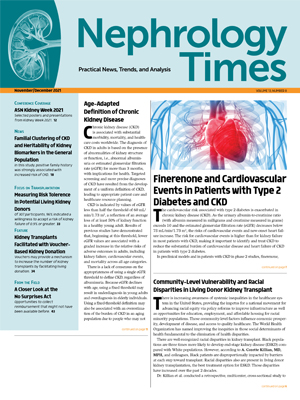
Managing blood pressure is probably the most important intervention that a nephrologist pursues in slowing kidney progression and reducing cardiovascular risk in CKD patients.
The publication earlier this year1 of the Kidney Disease Improving Global Outcomes (KDIGO) blood pressure (BP) management guidelines for CKD patients coupled with the commentaries that followed2-4 generated two recommendations that caught my eye. Foremost and strongest was a level 1B recommendation that blood pressure management should be standardized. The second and weaker recommendation was “adults with high BP and CKD be treated with a target SBP of <120 mmHg, when tolerated, using standardized office BP measurements” (level 2B recommendation).
The standardization of BP measurement is not something we emphasize in managing BP. Still, based on the latest guidelines it appears to be a key issue in managing BP, especially if one does it aggressively and aims for a systolic BP target of <120 mmHg.
A 2017 study on standardization of BP by Rajiv Agarwal, MD, from Indiana5 is worth spending some time on. This was a single-center study based at the Indiana VA. Dr. Agarwal recruited 275 patients with chronic kidney disease who had a BP <140/90 mm Hg when they came to the clinic. The patients were overwhelmingly men (because this was a VA population) and were on three BP medications on average.
Agarwal measured BP in a similar way to the SPRINT study. BP measurement was done generally with the patient in fasting state and in the morning. He used the Omron HEM 907 oscillometric monitor (Omron Healthcare) and ensured that the cuff size was appropriate for the arm. The participant rested quietly for 5 minutes in a seated position with the arm at the level of the heart. Three consecutive recordings approximately 30 seconds apart were made and no observer was present in the room during these measurements. The BP was deemed “research-grade.” The technique was similar to that reported in the SPRINT study and in the ACCORD study (although in ACCORD there was no 5-minute quiet period).
Agarwal reported that the research‐grade systolic BP was 12.7 mm Hg lower with wide limits of agreement (−46.1 to 20.7 mm Hg) as compared with routine clinic measurements. Research grade systolic BP was 7.9 mm Hg lower than daytime ambulatory systolic BP and had wide agreement limits (−33.2 to 17.4 mm Hg). Even setting aside the relative inaccuracy of research-grade BP, the point is that research‐grade BPs were substantially lower than routinely measured single recordings in the clinic. Agarwal concluded that if one wants to take an aggressive SPRINT-like approach in targeting a systolic BP of <120 mmHg, it is important to use the research-grade BP methodology.
Agarwal also measured left ventricular hypertrophy by echocardiography and reported that the relationship of routine clinic recordings to target organ damage measured by echocardiographic recordings was weaker compared with research‐grade or ambulatory BP recordings, further supporting the idea of adopting research-grade methodology in clinic for managing BP.
The KDIGO guideline working group writes: “It is recognized that standardized BP measurements increase the burden to patients, healthcare providers, and healthcare facilities. However, this recommendation is rated as strong because the working group considers it to be essential and it outweighs any potential burden to its implementation. The recommendation should be widely adopted in clinical practice since accurate measurements will ensure that proper guidance is being applied to the management of BP, as it is to the management of other risk factors.”
The other question one could ask is whether a “fudge factor” applied to adjust down clinic BP reliably estimates research-grade BP. The answer is no: the relationship between routine office BP and standardized office BP is highly variable, for individuals with and without CKD.
So my take on this is that every nephrologist who sees patients with CKD needs to look at how BP is measured in his or her practice and move in the direction of adopting research-grade processes in measuring BP. It is one more thing to do, but it is likely to be very worthwhile if one wants to aggressively manage BP in both slowing kidney progression and reducing cardiovascular risk.
References
- Cheung AK, Chang TI, Cushman WC, et al. Executive summary of the KDIGO 2021 Clinical Practice Guideline for the Management of Blood Pressure in Chronic Kidney Disease. Kidney Int. 2021 Mar;99(3):559-569. doi: 10.1016/j.kint.2020.10.026.
- Foti KE, Wang D, Chang AR, et al. Potential implications of the 2021 KDIGO blood pressure guideline for adults with chronic kidney disease in the United States. Kidney Int. 2021 Mar;99(3):686-695. doi: 10.1016/j.kint.2020.12.019.
- Wheeler DC, Becker GJ. Summary of KDIGO guideline. What do we really know about management of blood pressure in patients with chronic kidney disease? Kidney Int. 2013 Mar;83(3):377-83. doi: 10.1038/ki.2012.425. Epub 2013 Jan 16.
- Mann JFE, Chang TI, Cushman WC, et al. Commentary on the KDIGO 2021 Clinical Practice Guideline for the Management of Blood Pressure in CKD. Curr Cardiol Rep. 2021 Aug 16;23(9):132. doi: 10.1007/s11886-021-01559-3. PMID: 34398316; PMCID: PMC8366157.
- Agarwal R. Implications of blood pressure measurement technique for implementation of Systolic Blood Pressure Intervention Trial (SPRINT). J Am Heart Assoc. 2017;6:e004536. This key paper demonstrated that in individuals with CKD, there is a wide variability in terms of BP measured routinely versus. by standardized technique, and that these differences are unpredictable in any given individual.







 © 2025 Mashup Media, LLC, a Formedics Property. All Rights Reserved.
© 2025 Mashup Media, LLC, a Formedics Property. All Rights Reserved.